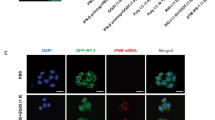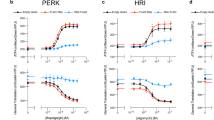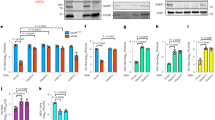Abstract
To characterize the mechanisms underlying apoptosis induced by viral infection, transcriptional activation of genes encoding members of the ‘BH3-only’ family of proteins was analysed during the course of virus infection. Among these genes, only NOXA is transcriptionally activated by vesicular stomatitis virus (VSV), sendai virus (SV), measles virus, herpes simplex virus, or dsRNA and required for efficient apoptosis of cells. Transcriptional activation of NOXA by VSV or SV is independent of p53, but requires the presence of interferon regulatory factor 1 (IRF-1), IRF-3 and cAMP-responsive element binding protein (CREB). Binding to and transactivation of the NOXA promoter by each of these transcription factors is governed by post-translational modification involving different pathways for each factor. Thus, SV infection activates IRF-3 and CREB by phosphorylation triggered by Toll like receptor 3 signalling, and a pathway involving calcium-independent phopholipase A2, respectively. In addition transactivation induced by IRF-1 during viral infection correlates with a 10 kDa increase in its molecular weight, suggesting a covalent linkage with a previously unknown regulatory polypeptide.
This is a preview of subscription content, access via your institution
Access options
Subscribe to this journal
Receive 50 print issues and online access
$259.00 per year
only $5.18 per issue
Buy this article
- Purchase on Springer Link
- Instant access to full article PDF
Prices may be subject to local taxes which are calculated during checkout








Similar content being viewed by others
References
Biron CA, Nguyen KB, Pien GC, Cousens LP, Salazar-Mather TP . (1999). Annu Rev Immunol 17: 189–220.
Bouker KB, Skaar TC, Fernandez DR, O’Brien KA, Riggins RB, Cao D et al. (2004). Cancer Res 64: 4030–4039.
Castelli JC, Hassel BA, Wood KA, Li XL, Amemiya K, Dalakas MC et al. (1997). J Exp Med 186: 967–972.
Chow WA, Fang JJ, Yee JK . (2000). J Immunol 164: 3512–3518.
Fitzgerald KA, McWhirter SM, Faia KL, Rowe DC, Latz E, Golenbock DT et al. (2003). Nat Immunol 4: 491–496.
Geiss G, Jin G, Guo J, Bumgarner R, Katze MG, Sen GC . (2001). J Biol Chem 276: 30178–30182.
Heylbroeck C, Balachandran S, Servant MJ, DeLuca C, Barber GN, Lin R et al. (2000). J Virol 74: 3781–3792.
Licata JM, Harty RN . (2003). Int Rev Immunol 22: 451–476.
Lin R, Heylbroeck C, Pitha PM, Hiscott J . (1998). Mol Cell Biol 18: 2986–2996.
Lyles DS . (2000). Microbiol Mol Biol Rev 64: 709–724.
Maggi Jr LB, Moran JM, Scarim AL, Ford DA, Yoon JW, McHowat J et al. (2002). J Biol Chem 277: 38449–38455.
Marques JT, Rebouillat D, Ramana CV, Murakami J, Hill JE, Gudkov A et al. (2005). J Virol 79: 11105–11114.
Martinson BD, Albert CJ, Corbett JA, Wysolmerski RB, Ford DA . (2003). J Lipid Res 44: 1686–1691.
Meylan E, Curran J, Hofmann K, Moradpour D, Binder M, Bartenschlager R et al. (2005). Nature 437: 1167–1172.
Miro-Mur F, Meiller A, Haddada H, May E . (2003). Oncogene 22: 5451–5456.
Moehler M, Blechacz B, Weiskopf N, Zeidler M, Stremmel W, Rommelaere J et al. (2001). Cancer Gene Ther 8: 158–167.
Moran JM, Buller RM, McHowat J, Turk J, Wohltmann M, Gross RW et al. (2005). J Biol Chem 280: 28162–28168.
Moro A, Santos A, Arana MJ, Perea SE . (2000). Biochem Biophys Res Commun 269: 31–34.
Munsch D, Watanabe-Fukunaga R, Bourdon JC, Nagata S, May E, Yonish-Rouach E et al. (2000). J Biol Chem 275: 3867–3872.
Nakagawa K, Yokosawa H . (2000). Eur J Biochem 267: 1680–1686.
Nakagawa K, Yokosawa H . (2002). FEBS Lett 530: 204–208.
Oda E, Ohki R, Murasawa H, Nemoto J, Shibue T, Yamashita T et al. (2000). Science 288: 1053–1058.
Osborn L, Kunkel S, Nabel GJ . (1989). Proc Natl Acad Sci USA 86: 2336–2340.
Pestka S, Langer JA, Zoon KC, Samuel CE . (1987). Annu Rev Biochem 56: 727–777.
Pine R, Decker T, Kessler DS, Levy Jr DE, Darnell JE . (1990). Mol Cell Biol 10: 2448–2457.
Puthalakath H, Strasser A . (2002). Cell Death Differ 9: 505–512.
Ruiz-Ruiz C, Ruiz de Almodovar C, Rodriguez A, Ortiz-Ferron G, Redondo JM, Lopez-Rivas A . (2004). J Biol Chem 279: 19712–19720.
Sanceau J, Hiscott J, Delattre O, Wietzerbin J . (2000). Oncogene 19: 3372–3383.
Sun Y, Leaman DW . (2005). J Biol Chem 280: 15561–15568.
Takaoka A, Hayakawa S, Yanai H, Stoiber D, Negishi H, Kikuchi H et al. (2003). Nature 424: 516–523.
Tanaka N, Ishihara M, Lamphier MS, Nozawa H, Matsuyama T, Mak TW et al. (1996). Nature 382: 816–818.
Tanaka N, Sato M, Lamphier MS, Nozawa H, Oda E, Noguchi S et al. (1998). Genes Cells 3: 29–37.
Taniguchi T, Ogasawara K, Takaoka A, Tanaka N . (2001). Annu Rev Immunol 19: 623–655.
Villunger A, Michalak EM, Coultas L, Mullauer F, Bock G, Ausserlechner MJ et al. (2003). Science 302: 1036–1038.
Weaver BK, Ando O, Kumar KP, Reich NC . (2001). FASEB J 15: 501–515.
Weaver BK, Kumar KP, Reich NC . (1998). Mol Cell Biol 18: 1359–1368.
Williams SD, Ford DA . (2001). Am J Physiol Heart Circ Physiol 281: H168–H176.
Xie R, van Wijnen AJ, van Der Meijden C, Luong MX, Stein JL, Stein GS . (2001). J Biol Chem 276: 18624–18632.
Yamamoto M, Sato S, Mori K, Hoshino K, Takeuchi O, Takeda K et al. (2002). J Immunol 169: 6668–6672.
Yamamoto M, Takeda K, Akira S . (2004). Mol Immunol 40: 861–868.
Yoneyama M, Fujita T . (2004). Uirusu 54: 161–167.
Acknowledgements
B Blanchard is supported by the Association pour la Recherche sur le Cancer (Villejuif, France).
Author information
Authors and Affiliations
Corresponding author
Rights and permissions
About this article
Cite this article
Lallemand, C., Blanchard, B., Palmieri, M. et al. Single-stranded RNA viruses inactivate the transcriptional activity of p53 but induce NOXA-dependent apoptosis via post-translational modifications of IRF-1, IRF-3 and CREB. Oncogene 26, 328–338 (2007). https://doi.org/10.1038/sj.onc.1209795
Received:
Revised:
Accepted:
Published:
Issue Date:
DOI: https://doi.org/10.1038/sj.onc.1209795
Keywords
This article is cited by
-
BCL-2 protein family: attractive targets for cancer therapy
Apoptosis (2023)
-
Upregulation of Interferon Regulatory Factor 6 Promotes Neuronal Apoptosis After Traumatic Brain Injury in Adult Rats
Cellular and Molecular Neurobiology (2016)
-
Viral double-stranded RNA sensors induce antiviral, pro-inflammatory, and pro-apoptotic responses in human renal tubular epithelial cells
Kidney International (2012)
-
Preferential involvement of mitochondria in Toll-like receptor 3 agonist-induced neuroblastoma cell apoptosis, but not in inhibition of cell growth
Apoptosis (2012)
-
Chemotherapeutic drugs sensitize human renal cell carcinoma cells to ABT-737 by a mechanism involving the Noxa-dependent inactivation of Mcl-1 or A1
Molecular Cancer (2010)



